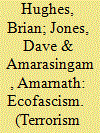|
|
|
Sort Order |
|
|
|
Items / Page
|
|
|
|
|
|
|
| Srl | Item |
| 1 |
ID:
175746


|
|
|
|
|
| Summary/Abstract |
Despite a pervasive concern among law enforcement and security agencies, there are relatively few academic explorations of the likelihood of violence associated with anti-authority activists from groups such as the Freemen-on-the-Land, Sovereign Citizens, and similar movements within Canada. In order to begin addressing this gap in knowledge, this article uses a multi-method approach to explore and assess the potential for violence by the Canadian anti-authority community against the state in particular. Data were gathered from interviews with law enforcement, lawyers, judges, notaries, and movement adherents (n = 32), as well as from the analysis of open source data which included media reports, court documents, and movement websites. Results suggest that there are three distinct classes of violent activity, directed specifically at the state and state actors, that are prevalent among Canadian anti-authority movements: a) offensive/extremist violence; b) defensive/reactionary violence; and c) harassment and intimidation. The article concludes with a discussion of two emerging areas of concern related to Canadian anti-authority violence and responses to the anti-authority community in Canada.
|
|
|
|
|
|
|
|
|
|
|
|
|
|
|
|
| 2 |
ID:
188064


|
|
|
|
|
| Summary/Abstract |
With Patrick Crusuis’ 2019 attack that killed twenty-two people in El Paso, Texas, discussions of ecofascism were thrust into mainstream news outlets and magazines. In his manifesto, Crusius described himself as an “ecofascist” seeking to challenge the “environmental warfare” of immigration. His choice of target, a Walmart frequented by Mexican immigrants, reflects this ideological connection between ecological priorities and violent white supremacist ideology. In this paper, the authors provide a review of existing theoretical literature on ecofascism to identify its key characteristics, namely, its Romantic sensibilities, anti-humanism, and mysticism. The authors argue that these features distinguish ecofascism from what other scholars have deemed “far-right ecologisms.” Following this, the authors draw on a larger corpus of data gathered from Twitter and Telegram between November 2019 and November 2020 to identify common themes in ecofascist circles, including the thinkers they frequently cite. The dataset examined shows notable differences in the types of content shared in ecofascist groups compared to the far-right more broadly.
|
|
|
|
|
|
|
|
|
|
|
|
|
|
|
|
|
|
|
|
|